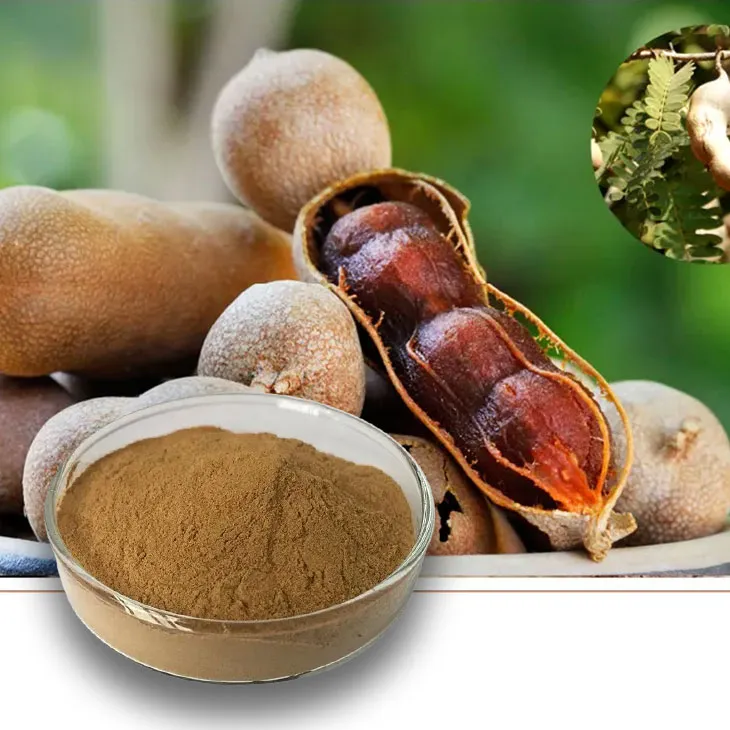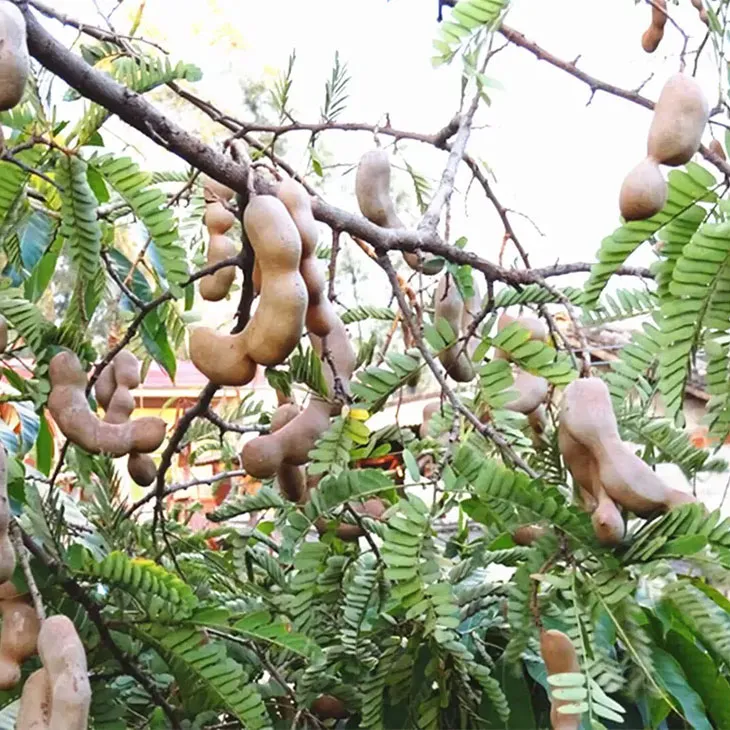- 0086-571-85302990
- sales@greenskybio.com
The process of extracting tamarind polysaccharide from tamarind extract powder.
2024-11-28

1. Introduction to Tamarind extract powder
Tamarind extract powder is a valuable source for various bioactive compounds, especially polysaccharides. It is obtained from the tamarind fruit, which is native to tropical regions. The powder contains a complex mixture of components including proteins, fibers, and minerals along with the polysaccharides. Understanding the nature of this powder is crucial before starting the extraction process of polysaccharides. Its chemical composition can vary depending on factors such as the variety of tamarind, the extraction method used to obtain the powder, and the environmental conditions during growth. Physically, the powder can have different particle sizes and textures, which may also affect the extraction process.

2. Methods of Extraction
2.1 Enzymatic Extraction
Enzymatic extraction is one of the promising methods for obtaining tamarind polysaccharides. Specific enzymes are used to break down the complex matrix of the Tamarind extract powder and release the polysaccharides. For example, cellulases and hemicellulases can be employed. These enzymes target the cell wall components of the powder, which are often associated with the polysaccharides. The enzymatic reaction is highly specific and can be optimized for better yields. The process involves adding the appropriate amount of enzyme to the tamarind extract powder suspension. The reaction conditions such as temperature and pH need to be carefully controlled. Generally, a temperature range of 30 - 50°C and a pH in the range of 4 - 7 are often suitable for most enzymatic reactions related to polysaccharide extraction from tamarind.
2.2 Solvent Extraction
Solvent extraction is another commonly used method. Different solvents can be used depending on the solubility characteristics of the polysaccharides. Water is often a primary solvent as tamarind polysaccharides are generally hydrophilic. However, in some cases, a combination of water with other solvents such as ethanol can be used. This method involves mixing the tamarind extract powder with the solvent in a suitable ratio. For example, a ratio of 1:10 (powder:solvent) can be a starting point, but this may need to be optimized. The mixture is then stirred for a specific period of time, usually ranging from 1 - 6 hours. After that, the extract is separated from the residue using techniques such as filtration or centrifugation.
2.3 Microwave - Assisted Extraction
Microwave - assisted extraction has gained popularity in recent years. The principle behind this method is that microwaves can heat the sample rapidly and uniformly, which can enhance the extraction efficiency. In the case of tamarind polysaccharide extraction, the tamarind extract powder is mixed with the solvent (usually water) and placed in a microwave - compatible vessel. The microwave power and irradiation time are important parameters to be optimized. For example, a microwave power of 300 - 600 W and an irradiation time of 5 - 15 minutes can be considered. This method can significantly reduce the extraction time compared to traditional methods, while also potentially increasing the yield of polysaccharides.

3. Optimization of Extraction Conditions
3.1 pH
The pH of the extraction medium plays a vital role in the extraction of tamarind polysaccharides. Different polysaccharides may have different solubility and stability at different pH values. For instance, some polysaccharides may be more soluble in slightly acidic conditions, while others may be better extracted at a neutral or slightly alkaline pH. In general, a pH range of 4 - 7 is often explored for optimal extraction. Adjusting the pH can be done using buffers such as citrate buffer or phosphate buffer. By carefully controlling the pH, the extraction efficiency can be maximized, and the quality of the extracted polysaccharides can be maintained.
3.2 Extraction Time
The extraction time is another crucial factor. If the extraction time is too short, the polysaccharides may not be fully released from the tamarind extract powder. On the other hand, if the extraction time is too long, it may lead to degradation of the polysaccharides or the extraction of unwanted impurities. For enzymatic extraction, the extraction time can range from 1 - 4 hours depending on the enzyme activity and the amount of substrate (tamarind extract powder). For solvent extraction, as mentioned earlier, it can be from 1 - 6 hours. For microwave - assisted extraction, the time is usually shorter, typically in the range of 5 - 15 minutes. Optimizing the extraction time for each method is necessary to obtain high - quality tamarind polysaccharides.
3.3 Solvent - to - Sample Ratio
The ratio of solvent to sample (tamarind extract powder) also affects the extraction process. A higher solvent - to - sample ratio may increase the solubility of the polysaccharides and improve the extraction efficiency. However, it also means using more solvent, which may increase the cost and the complexity of the subsequent separation process. A common solvent - to - sample ratio for solvent extraction can range from 5:1 to 20:1. For enzymatic extraction, the amount of solvent used should be sufficient to ensure proper mixing and reaction of the enzyme with the powder. Finding the optimal solvent - to - sample ratio is important for both economic and efficiency reasons.

4. Post - Extraction Processing
4.1 Filtration and Centrifugation
After the extraction process, the extract needs to be separated from the insoluble residue. Filtration and centrifugation are two common techniques used for this purpose. Filtration can be carried out using filter papers or membranes with different pore sizes depending on the nature of the residue. For example, a filter paper with a pore size of 0.45 μm can be used for initial filtration. Centrifugation can be more effective for separating finer particles. A centrifugal force of 3000 - 5000 rpm for 10 - 20 minutes can be applied to obtain a clear supernatant containing the polysaccharides.
4.2 Drying
Once the polysaccharides are separated from the residue, drying is required to obtain a stable product. There are different drying methods available, such as air drying, freeze - drying, and spray - drying. Air drying is the simplest method, but it may take a longer time and may not be suitable for heat - sensitive polysaccharides. Freeze - drying can preserve the structure and activity of the polysaccharides better, but it is a more expensive method. Spray - drying is a relatively fast method and can produce a powder form of the polysaccharides, which is convenient for storage and further applications. However, it may require some optimization of the drying parameters such as inlet and outlet temperatures and the flow rate of the feed solution.

5. Applications of Tamarind Polysaccharides
5.1 In Nutrition
Tamarind polysaccharides can act as dietary fiber in the field of nutrition. Dietary fiber is important for maintaining a healthy digestive system. It can help in preventing constipation, reducing cholesterol levels, and regulating blood sugar levels. Tamarind polysaccharides, being a natural source of fiber, can be incorporated into various food products such as baked goods, cereals, and beverages. They can also be used as a thickening agent or stabilizer in food formulations, providing both functional and nutritional benefits.
5.2 In the Pharmaceutical Industry
In the pharmaceutical industry, tamarind polysaccharides have great potential in the development of novel drug delivery systems. They can be used to encapsulate drugs, protecting them from degradation in the body and controlling their release. For example, polysaccharides can form hydrogels, which can be loaded with drugs and then slowly release the drugs at the target site. This can improve the efficacy of drugs and reduce their side effects. Additionally, tamarind polysaccharides may have some biological activities such as antioxidant and anti - inflammatory properties, which can be further explored for the development of new drugs or nutraceuticals.
6. Conclusion
The process of extracting tamarind polysaccharides from tamarind extract powder is a complex but rewarding one. By carefully considering the nature of the powder, choosing the appropriate extraction method, and optimizing the extraction conditions, high - quality tamarind polysaccharides can be obtained. These polysaccharides have significant applications in nutrition and the pharmaceutical industry, among others. Further research is still needed to fully explore the potential of tamarind polysaccharides and to develop more efficient and sustainable extraction and application methods.
FAQ:
What are the main factors to consider when starting the extraction of tamarind polysaccharides from tamarind extract powder?
When starting the extraction, one needs to consider the chemical composition and physical properties of the tamarind extract powder. These aspects can influence the choice of extraction method and the overall extraction efficiency.
Why is enzymatic extraction considered for obtaining tamarind polysaccharides?
Enzymatic extraction is considered because specific enzymes can break down the complex matrix in the tamarind extract powder. This helps in releasing the polysaccharides more effectively compared to other methods.
How can the extraction conditions be optimized for tamarind polysaccharide extraction?
The extraction conditions can be optimized by carefully adjusting factors such as pH, extraction time, and solvent - to - sample ratio. By finding the optimal values for these parameters, the yield and quality of the extracted polysaccharides can be improved.
What is the importance of drying the obtained tamarind polysaccharides?
Drying the obtained tamarind polysaccharides is important to obtain a stable product. It helps in preserving the polysaccharides and making them suitable for further applications in areas like nutrition and pharmaceuticals.
What are the applications of tamarind polysaccharides in the pharmaceutical industry?
In the pharmaceutical industry, tamarind polysaccharides can be used in the development of novel drug delivery systems. They can play a role in improving the effectiveness and safety of drug delivery.
Related literature
- Extraction and Characterization of Tamarind Polysaccharides: A Review"
- "Optimization of Tamarind Polysaccharide Extraction: A Comprehensive Study"
- "Tamarind Polysaccharides: Properties and Their Potential in Nutrition and Pharmaceutical Applications"
- ▶ Hesperidin
- ▶ Citrus Bioflavonoids
- ▶ Plant Extract
- ▶ lycopene
- ▶ Diosmin
- ▶ Grape seed extract
- ▶ Sea buckthorn Juice Powder
- ▶ Fruit Juice Powder
- ▶ Hops Extract
- ▶ Artichoke Extract
- ▶ Mushroom extract
- ▶ Astaxanthin
- ▶ Green Tea Extract
- ▶ Curcumin
- ▶ Horse Chestnut Extract
- ▶ Other Product
- ▶ Boswellia Serrata Extract
- ▶ Resveratrol
- ▶ Marigold Extract
- ▶ Grape Leaf Extract
- ▶ New Product
- ▶ Aminolevulinic acid
- ▶ Cranberry Extract
- ▶ Red Yeast Rice
- ▶ Red Wine Extract
-
Berberis aristata Extract
2024-11-28
-
Coix Seed Extract
2024-11-28
-
Calendula Extract
2024-11-28
-
Bilberry Extract
2024-11-28
-
Mulberry leaf Extract
2024-11-28
-
Shikone Extract
2024-11-28
-
Hedyotis Diffusa Extract
2024-11-28
-
Almond Extract Powder
2024-11-28
-
Agaricus Blazei Extract
2024-11-28
-
Grapefruit Seed Extract Powder
2024-11-28





















